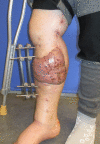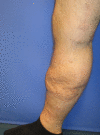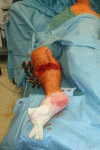Multistep reconstruction of a post-traumatic defect in the lower limb with AV loop and free myocutaneous latissimus dorsi flap combined with a perforator monitor skin island after loss of ALT flap
- PMID: 34194916
- PMCID: PMC8204669
- DOI: 10.3205/iprs000155
Multistep reconstruction of a post-traumatic defect in the lower limb with AV loop and free myocutaneous latissimus dorsi flap combined with a perforator monitor skin island after loss of ALT flap
Abstract
Crush injuries of the lower extremity with extensive osseous and soft tissue damage impose a big challenge even for an interdisciplinary reconstructive approach. Multistep reconstruction with negative wound pressure therapy for soft tissue management and external fixation for osseous stability preceding free flap transfer leads to optimized outcome. We report the successful multistep reconstruction of a third-degree open right tibial fracture with extensive soft tissue defect with an arteriovenous loop preceding latissimus dorsi flap coverage with a perforator skin island after loss of an anterior lateral thigh (ALT) flap due to intima damage of the recipient vessels. The described method is a safe reconstructive concept after primary flap loss with persistent extensive tissue damage.
Quetschverletzungen der unteren Extremität mit ausgedehnter Knochen- und Weichteilschädigung stellen selbst für interdisziplinäre rekonstruktive Konzepte eine große Herausforderung dar. Eine sequenzielle Herangehensweise, bestehend aus einem Unterdruckverband gestützten Weichteilmanagement sowie einer Knochenstabilisierung mittels Fixateur externe vor freiem Gewebetransfer, führt zu einem verbessertem Outcome. Wir berichten über die erfolgreiche mehrstufige Rekonstruktion einer rechtsseitigen, drittgradig offenen Tibiafraktur mit ausgedehntem Weichteildefekt mittels einer arteriovenösen Gefäßschleife und folgendem Latissimus dorsi Lappentransfer mit einer perforatorbasierten Hautinsel nach anterior lateral thigh (ALT) Lappenverlust durch Intimaschaden der Anschlussgefäße. Die beschriebene Methode stellt ein sicheres rekonstruktives Konzept nach Lappenverlust mit konsekutiv persistierendem Gewebedefekt dar.
Keywords: latissimus dorsi; lower limb; microsurgery; plastic surgery; reconstruction.
Copyright © 2021 Summer et al.
Conflict of interest statement
The authors declare that they have no competing interests.
Figures
















References
-
- Sop JL, Sop A. StatPearls. Treasure Island (FL): StatPearls Publishing; 2020. [cited 2020 Dec 1]. Open Fracture Management. Available from: http://www.ncbi.nlm.nih.gov/books/NBK448083/ - PubMed
-
- Singhal M, Naalla R, Dave A, Moumita De null, Gupta D, Chauhan S. The role of plastic and reconstructive surgeon in trauma care: Perspectives from a Level 1 trauma centre in India. Indian J Plast Surg Off Publ Assoc Plast Surg India. 2018 Aug;51(2):170–176. doi: 10.4103/ijps.IJPS_212_17. - DOI - PMC - PubMed
Publication types
LinkOut - more resources
Full Text Sources

